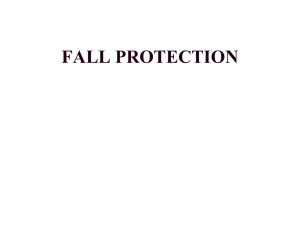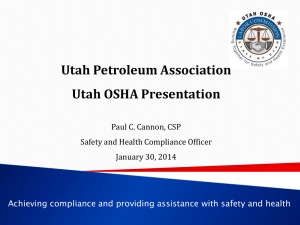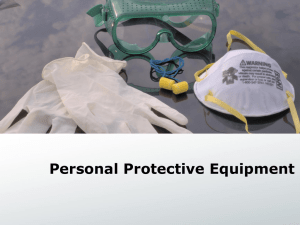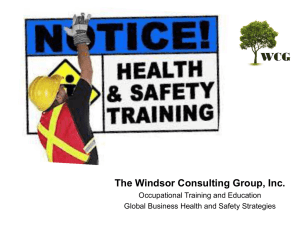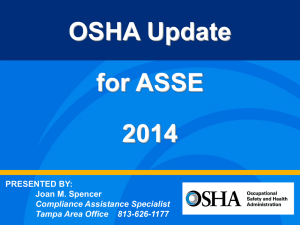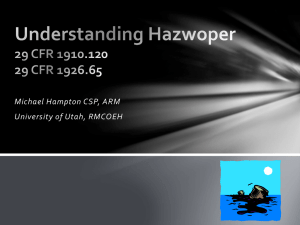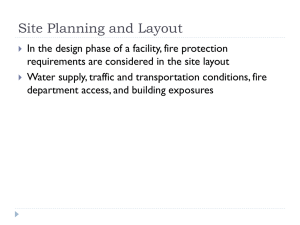Presentation - Quality & Health
advertisement
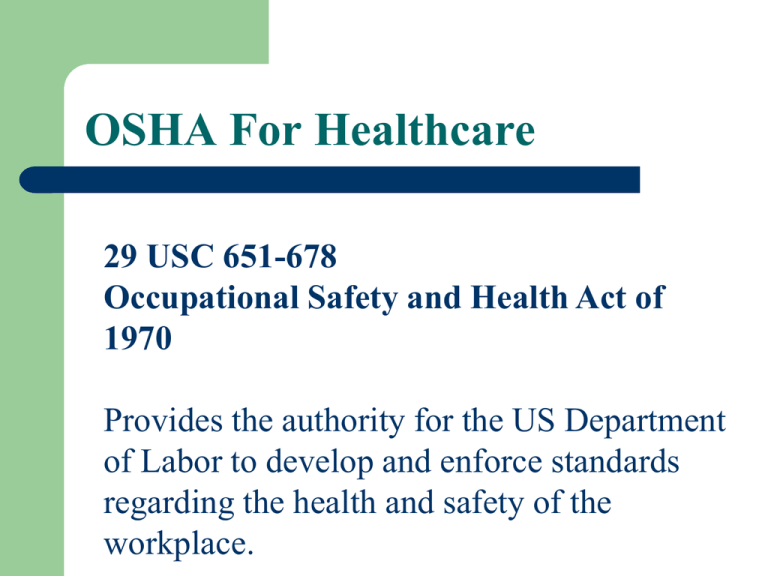
OSHA For Healthcare 29 USC 651-678 Occupational Safety and Health Act of 1970 Provides the authority for the US Department of Labor to develop and enforce standards regarding the health and safety of the workplace. OSHA “General Duty Clause” 29 USC 654 SEC. 5. DUTIES (a) Each employer – (1)shall furnish to each of his employees employment and a place of employment which are free from recognized hazards that are causing or are likely to cause death or serious physical harm to his employees; (2)shall comply with occupational safety and health standards promulgated under this Act. “General Duty Clause” (b)Each employee shall comply with occupational safety and health standards and all rules, regulations, and orders issued pursuant to this Act which are applicable to his own actions and conduct. OSHA Regulations Regulations are located in Title 29 of the Code of Federal Regulations (29 CFR) Some key regulations in 29 CRF are: 29 CFR 1903 – Inspections, Posting Requirements, and Citations 29 CFR 1904 – Recordkeeping and Reporting 29 CFR 1910 – General Industry 29 CFR 1926 - Construction OSHA Posting Requirements Required Postings Information about OSHA and basic employee rights under the act. – A poster is available for the Department of Labor for this purpose. An annual summary of occupational illness and injuries from the previous year OSHA Recordkeeping Each establishment must maintain records of occupational injuries and illnesses. TOP Required Forms: OSHA 300 – Annual log and summary OSHA 300A – Calendar year summary Must be posted from February 1 until April 30 OSHA 301 – Additional details on the injuries recorded on the OSHA 300 log OSHA Recordkeeping The length of time records must be maintained varies. The OSHA “300” records must be maintained for a five year period. Other records may have to be maintained for much longer periods of time. – i.e. Employee exposure records must be maintained for the length of employment plus 30 years OSHA Recordability Injuries must be evaluated to determine whether or not they are recordable under the OSHA regulations. Worker’s Compensation Injuries and OSHA recordability do not always align so be sure to evaluate every injury to be sure it is properly classified. OSHA Injury Reporting Certain injuries require direct reporting to OSHA and The Rules are changing! Starting January 1, 2015 An employer is required to report a fatality, inpatient hospitalization, amputation, or loss of an eye if the event is reported to employer or employer’s agent(s). OSHA Injury Reporting Employers are required to report a fatality within 8 hours of the death, for all fatalities occurring within 30 days of the incident. Employers are required to report each in-patient hospitalization within 24 hours of the hospitalization, for all hospitalizations occurring within 24 hours of the work-related incident. OSHA Injury Reporting Employers required to report each amputation within 24 hours of the amputation, for all amputations occurring within 24 hours of the workrelated incident. Employers required to report each loss of an eye within 24 hours of the loss of an eye, for all losses of an eye occurring within 24 hours of the workrelated incident. OSHA 29 CFR 1910 Overview 29 CFR contains numerous subparts which have specific requirements for reducing risk to workers. Many of these regulations have application in the healthcare setting. Note: 29 CFR 1926 contains regulations related to construction which may apply during renovation and construction at healthcare facilities. OSHA 29 CFR 1910 Subpart Z Toxic and Hazardous Substances 1910.1200 - Hazard Communication TOP Recently updated to incorporate the Globally Harmonized System – Formal hazard communication plan – Inventory of hazardous chemicals – Ensure training, labeling, and SDS maintenance – Training at the time of initial assignment, when a new hazard is introduced into the worksite, and when transferred to a new department OSHA 29 CFR 1910 Subpart Z Toxic and Hazardous Substances 1910.1030 - Bloodborne pathogens. TOP – – – – – Formal Exposure control plan Categorize exposure potential Hepatitis B Vaccine Engineering controls PPE OSHA eTool: https://www.osha.gov/SLTC/etools/hospital/hazards/bbp/bbp.ht ml OSHA 29 CFR 1910 Subpart Z Toxic and Hazardous Substances 1910.1001 - Asbestos. – Asbestos-containing materials (ACM) are materials that contain at least 1% asbestos – All construction projects performed where asbestos may be disturbed should be monitored – Building owner must determine the presence, amount, location, and type of asbestos in the facility, and can be held accountable for subcontractor activities OSHA 29 CFR 1910 Subpart Z Toxic and Hazardous Substances 1910.1025 – Lead – Buildings constructed prior to 1980 may have lead in the paint or pipes. Radiology and nuclear medicine areas also have lead present. – Develop a proactive lead management program. OSHA 29 CFR 1910 Subpart Z Toxic and Hazardous Substances 1910.1047 - Ethylene oxide. – Assess all areas where EtO may be used and determine potential for exposure. This usually means air sampling. – Use engineering controls and work practices to eliminate or reduce employee exposure at or below the permissible exposure limits (PEL) – Medical surveillance program OSHA 29 CFR 1910 Subpart Z Toxic and Hazardous Substances 1910.1048 - Formaldehyde. – Determine potential exposure in areas where chemicals containing 0.1% or greater formaldehyde are used. – Conduct exposure monitoring – Engineering and workplace controls should be maintained to keep employee exposure as low as possible. – An eyewash unit and drench shower shall be provide where formaldehyde is used OSHA 29 CFR 1910 Subpart Z Toxic and Hazardous Substances 1910.1052 - Methylene Chloride. 1910.1096 - Ionizing Radiation 1910.1450 - Occupational Exposure To Hazardous Chemicals In Laboratories Chemical Hygiene Plan Pharmacy eTool OSHA 29 CFR 1910 Subpart Z Toxic and Hazardous Substances Other chemicals that may need to be considered: – Xylene (PEL=100ppm, TLV=100ppm) – Glutaraldehyde (PEL=N/A, TLV=0.05ppm ceiling) – OPA (o-phthalaldehyde) may pose similar occupational hazards to those of glutaraldehyde – Anesthetic Gases OSHA 29 CFR 1910 Subpart Z Toxic and Hazardous Substances Other chemicals that may need to be considered: – Methyl Methacrylate (PEL=100ppm, TLV=50ppm) – Mercury (PEL=0.1 mg/m3, TLV=0.025 mg/m3) – Hazardous Drugs: See OSHA Technical Manual Section VI: Chapter 2 regarding a Hazardous Drug Safety and Health Plan OSHA 29 CFR 1910 Subpart K Medical and First Aid 1910.151 Medical Services And First Aid. TOP "Where the eyes or body of any person may be exposed to injurious corrosive materials, suitable facilities for quick drenching or flushing of the eyes and body shall be provided within the work area for immediate emergency use.“ – – Proper installation Maintenance OSHA 29 CFR 1910 Subpart I Personal Protective Equipment TOP 1910.134 - Respiratory Protection. – Formal Respiratory Protection Program – Must include procedures for selection and use, medical evaluation, fit testing, use, cleaning, training. – Medical evaluation – Fit testing – The respiratory protection program should be evaluated as often as necessary to ensure effectiveness OSHA 29 CFR 1910 Subpart I Personal Protective Equipment 1910.133 - Eye and face protection 1910.136 - Foot protection. 1910.137 - Electrical protective devices 1910.138 - Hand Protection OSHA 29 CFR 1910 Subpart G Occupational noise exposure. 1910.95 - Occupational Noise Exposure. – – If noise exposures are 85dBA for an eight hour time weighted average this standard applies. This may occur in certain mechanical areas or during lawn care. Some clinical areas may approach these levels as well. Hearing Conservation Program Audiometric testing Noise control OSHA 29 CFR 1910 Subpart J General Environmental Controls 1910.146 - Permit-required Confined Spaces Confined Space – Large enough and so configured so that an employee can enter and perform work. – Has limited or restricted means of entry or exit. – Is not designed for continuous occupancy. OSHA 29 CFR 1910 Subpart J General Environmental Controls Permit Required Confined Space – Hazardous atmosphere (or potential to contain a hazardous atmosphere) – Contains a material that may engulf an entrant – Has an internal configuration such that an entrant may become trapped by inwardly converging walls or a floor that slopes downward and tapers to a smaller crosssection. – Any other recognized serious safety or health hazard (e.g., electrical). OSHA 29 CFR 1910 Subpart J General Environmental Controls 1910.147 - The control of hazardous energy (lockout/tagout) – Establish a formal program servicing or maintenance on machinery or equipment where the unexpected energizing, startup or release of stored energy could occur and cause injury – Lockout and tagout devices shall be provided by the employer for isolating, securing, or blocking of machines or equipment from energy sources OSHA 29 CFR 1910 Subpart N Materials Handling and Storage 1910.183 – Helicopters 1910.178 - Powered Industrial Trucks – Formal program must be established for training and permitting operators – Classroom and practical training must be provided. Refresher training every three years. – Regular equipment inspection OSHA 29 CFR 1910 Subpart O and P 1910 Subpart O - Machinery and Machine Guarding 1910.212 - General Requirements For All Machines 1910.213 - Woodworking Machinery Requirements 1910.215 - Abrasive Wheel Machinery 1910 Subpart P - Hand and Portable Powered Tools and Other Hand-Held Equipment 1910.242 - Hand and portable powered tools and equipment, general 1910.243 - Guarding of portable powered tools OSHA 29 CFR 1910 Subpart S Electrical TOP 1910.304 - Wiring Design And Protection. 1910.305 - Wiring Methods, Components, And Equipment For General Use. 1910.306 - Specific Purpose Equipment And Installations. 1910.307 - Hazardous (Classified) Locations. 1910.332 - Training 1910.333 - Selection And Use Of Work Practices 1910.334 - Use Of Equipment. 1910.335 - Safeguards For Personnel Protection. Risk Assessment Some Helpful Links GHS Pictograms: https://www.osha.gov/Publications/OSHA3491QuickCardPictogram.pdf Chemical Hygiene Plan: https://www.osha.gov/Publications/laboratory/OSHAfactsheetlaboratory-safety-chemical-hygiene-plan.pdf Hazardous Drugs: https://www.osha.gov/dts/osta/otm/otm_vi/otm_vi_2.html#3 OSHA eTool Index: https://www.osha.gov/dts/osta/oshasoft/

